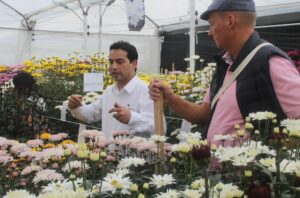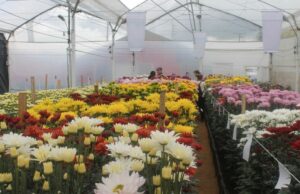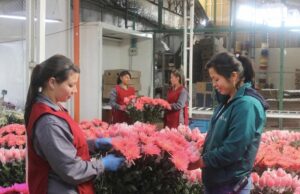Most of the Colombian chrysanthemum nurseries are located in Medellín. But chrysanthemum nursery Yasa is situated in Sabana de Bogotá. “It’s easier to grow chrysanthemums in Medellín, but we like a challenge.”
Because of Yasa’s higher altitude, the cultivation period is longer there than in Medellín, explains Ricardo Otero during our visit to one of the few chrysanthemum nurseries nearby Bogotá in the week of the Proflora trade show. Chrysanthemum is an important export product for Colombia. Last year, the exports reached a total value of $147 million. That made it the number three export flower, after rose and carnation.
Not in Medellín
Most of the Colombian chrysanthemums can be found in Medellín, an area with a very suitable climate for chrysanthemums. It’s warmer and more humid, which shortens the cultivation period. In the Sabana de Bogotá region, chrysanthemum isn’t a traditional product. The region is better known for rose and carnation. The higher altitude means that temperatures are lower than in Medellín and as a result, it takes 1.5 week longer to grow chrysanthemums.
Yasa never considered this as an obstacle though. In fact, they were looking for something difficult. The company has been around for 45 years and has a lot of experience in floriculture. “We know how to do it”, said Otero. It turns out that Yasa likes a challenge. “We prefer the hard way” is what we heard. And: “We like doing difficult things.”

In addition, the colder temperatures do come with some benefits, too: the colours of the chrysanthemums are more intense, the stems are stronger, the chrysanthemums produce more and larger flowers and they have a longer vase life. Sabana de Bogotá has less rainfall, 600mm per year on average, which means that they have fewer problems with botrytis. Otero is proud to tell us that Yasa won a gold medal for its Anastasia Green this year, on a floricultural trade show in Moscow.
Trial from six different breeders
Yasa’s greenhouses – 9ha in total – are filled with trials from six different breeders. New varieties are tested to determine if they make good spray chrysanthemums or disbuds. The signs show familiar names, such as Danziger, Deliflor, Progeny Breeding and Dümmen Orange. They test 150 varieties each year. Once or twice a year, the nursery is visited by customers and Yasa asks them which varieties they prefer. Customers also tell them which colours and which type of flowers they want during certain weeks, which is something that varies greatly during the course of the year. Yasa grows thirty different varieties in their greenhouses.

The company used to export mainly to the United States. At the moment, they’ve got three or four American customers left. Other important markets include Europe, Japan, Australia and Canada. Thanks to the favourable exchange rate of the peso against the dollar, the past three years have been very good. The ten years before that weren’t so great, because of the strong peso and the American crisis. When things weren’t going so well, Yasa decided to look for new markets, so that they could spread the risk in the future.
No steaming
What’s different at Yasa – and this is true for more chrysanthemum nurseries in Colombia – is that they don’t do any steaming. At the end of each cultivation round, all plant remnants – flowers, stems and roots – are removed and put on a big pile behind the greenhouse, where they are turned into compost with some water and bacteria. It takes three months to make the compost.
Compost goes back into the greenhouse each cultivation round, when it becomes the medium for new cultivation. Otero said that despite the fact that they don’t do any steaming, Yasa has no problems with fusarium. Regular testing confirms this. In general, it’s thrips, agromyzidae and rust that cause most of the problems in Colombian chrysanthemum nurseries.










